Multiple Choice
Identify the
choice that best completes the statement or answers the question.
|
|
|
Why did the Renaissance
begin in Italy ?
The years 1300 to 1600 saw a rebirth of learning and culture in Europe
called the Renaissance. This rebirth spread north from Italy. It began there for three
reasons. First, Italy had several important cities. Cities were places were places where people
exchanged ideas. Second, these cities included a class of merchants and bankers who were
becoming wealthy and powerful. This class strongly believed in the idea of individual achievement.
Third, Italian artists and scholars were inspired by the ruined buildings and other reminders of
classical Rome.
|
|
|
1.
|
In what country did the
Renaissance
start?
a. | France | c. | Rome | b. | Italy | d. | Greece |
|
|
|
2.
|
What inspired the artists and
writers of the Renaissance?
a. | Ancient
Egypt | c. | American
Cinema | b. | Ancient Rome | d. | Greek Military Might |
|
|
|
3.
|
Which group of people believed
in the power of the individual
a. | soldiers | c. | politicians | b. | artists | d. | bankers and merchants |
|
|
|
4.
|
What does Renaissance mean?
a. | political and social
freedom | c. | rebirth of
learning and culture | b. | return to the dark ages | d. | Italian power |
|
|
|
What new values did
people hold?
The
new interest in the classical past led to an important value in Renaissance
culture—humanism. This was a deep interest in what people have already achieved as well
as what they could achieve in the future. Scholars did not try to connect classical writings to
Christian teaching. Instead, they tried to understand them on their own terms.
In the Middle
Ages, the emphasis had been mostly on spiritual values. Renaissance thinkers stressed
secular ideas. These ideas centered on the things of the world. One way that powerful or
wealthy people showed this interest in worldly things was by paying artists, writers, and musicians
to create beautiful works of art. Wealthy people who supported artists were known as
patrons.
People tried to show that they could master many fields of study or work.
Someone who succeeded in many fields was admired greatly. The artist Leonardo da Vinci was an example
of this ideal. He was a painter, a scientist, and an inventor. Men were expected to be charming,
witty, well educated, well mannered, athletic, and self-controlled. Women were expected too have many
accomplishments too. But, women were not to show them in public.
|
|
|
5.
|
A Humanist is likely to focus
on
a. | the importance of the
church | c. | the importance of the individual
person | b. | the importance of Christianity | d. | the importance of the state |
|
|
|
6.
|
In the middle ages in Europe
people focused on
a. | spiritual
values | c. | Christianity | b. | the church | d. | all of these |
|
|
|
7.
|
Secular
means
a. | things of the
world | c. | Christianity | b. | religion | d. | Art |
|
|
|
8.
|
People who helped support
artists during the Renaissance were
called
a. | scientists | c. | secular monks | b. | patrons | d. | scholars |
|
|
|
9.
|
In the Renaissance people tried to show that they had _____
skills
a. | many | c. | no | b. | very few | d. | religious |
|
|
|
How did art change during
the Renaissance?
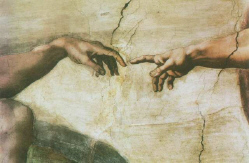 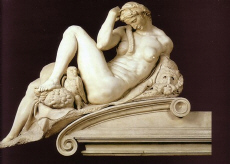
Renaissance artists sometimes
used new methods. Sculptors made figures more realistic than those from the Middle
Ages. Painters used perspective to create the illusion that their paintings were
three-dimensional. The subject of artwork changed also. Art in the Middle ages was mostly
religious. Renaissance artists reproduced other views of life. Michelangelo showed great skill as an
architect, a sculptor, and a painter.
|
|
|
10.
|
During the Renaissance artists tried to show that their art had
perspective. What does perspective mean?
a. | art that is one
dimensional | c. | art that is
abstract | b. | art that is three dimensional | d. | art that is colorful |
|
|
|
11.
|
_____ was a sculpture,
architect and painter.
a. | Van
Gogh | c. | Pope
Leo | b. | Leonardo DeCaprio | d. | Michelangelo |
|
|
|
How
did literature change
during the Renaissance?
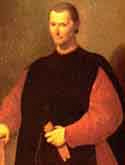
Renaissance writers also achieved greatness .
Several wrote in the vernacular. This means they wrote in their native languages. It was a change
from the Middle Ages, when most writing was done in Latin. Writers also changed their subject matter.
They began to express their own thoughts and feelings. Sometimes they gave a detailed look at an
individual. Dante and others wrote poetry, letters, and stories that were more re a l i s t i c .
Niccol Machiavelli took a new approach to understanding government. He focused on telling rulers how
to expand their power. He believed rulers should do what was politically effective, even if it was
not morally right.
|
|
|
12.
|
During the Middle Ages most
people wrote in
a. | Greek | c. | Latin | b. | Their native language | d. | English |
|
|
|
13.
|
This assignment is written
in
a. | the
vernacular | c. | Old
English | b. | Renaissance English | d. | pig Latin |
|
|
|
14.
|
Niccol Machiavelli was a
Renaissance writer who gave advice to
a. | politicians and
rulers | c. | scholars | b. | common people | d. | artists |
|
|
|
15.
|
Niccol Machiavelli advised
rulers that
a. | they should always do what was
morally correct | c. | they should do
whatever they needed to do to stay in power | b. | staying in power was not really very
important | d. | the people were more important than
power |
|
|
|
  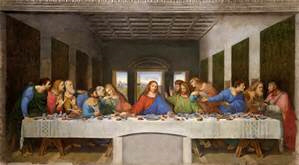
Leonardo,
Renaissance Man Leonardo da Vinci
(LAY? •uh? •NAHR? •doh duh? •VIHN? •chee) was a painter, sculptor,
inventor, and scientist. A true “Renaissance man,” he was interested in how things
worked. He studied how a muscle moves and how veins are arranged in a leaf. He filled his notebooks
with observations and sketches. Then he incorporated his findings in his art.
Among his many
masterpieces, Leonardo painted one of the best-known portraits in the world, the Mona Lisa
(page 44). The woman in the portrait seems so real that many writers have tried to explain the
thoughts behind her smile. Leonardo also produced a famous religious painting, The Last Supper.
It shows the personalities of Jesus’ disciples through facial expressions and body
positions.
|
|
|
16.
|
da Vinci was interested in how
things worked. He studied the human body and other things in nature. What did he do with this
knowledge?
a. | nothing | c. | taught physics at the
university | b. | made it part of his art | d. | kept it hidden so as not to anger the
pope |
|
|
|
17.
|
How does da Vinci show the
personalities of the disciples in the “Last Supper?”
a. | he does not show their
personalities, only what they looked like. | c. | through quotes from the bible | b. | through their facial expressions and body
positions | d. | through
perspective |
|
|
|
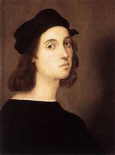 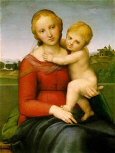 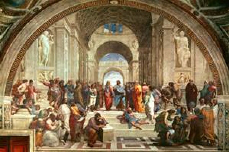
Raphael Advances
Realism Raphael (RAHF? •ee?
•uhl) Sanzio was younger than Michelangelo and Leonardo. He learned from studying their works.
One of Raphael’s favorite subjects was the Madonna and child. Raphael often portrayed their
expressions as gentle and calm. He was famous for his use of perspective.
In his greatest
achievement, Raphael filled the walls of Pope Julius II’s library with paintings. One of these,
School of Athens (page 45), conveys the classical influence on the Renaissance. Raphael
painted famous Renaissance figures, such as Michelangelo, Leonardo, and himself, as classical
philosophers and their students.
|
|
|
18.
|
In “Mother and
Child,” Raphael shows
a. | God and his
mother | c. | Mary and Jesus as real
people | b. | symbols rather than real people | d. | Mary and Jesus as two dimensional
symbols |
|
|
|
19.
|
What does the perspective in
the “School of Athens,” achieve?
a. | It makes the figures seem
real | c. | it makes the painting seem 2
dimensional and flat | b. | it make the painting seem humorous (funny) | d. | it makes the painting 3 dimensional with
depth |
|
Matching
|
|
|
a. | patron | d. | perspective | b. | secular | e. | Renaissance | c. | humanism | f. | vernacular |
|
|
|
20.
|
a Renaissance intellectual movement in which thinkers
studied classical texts and focused on human potential and achievements.
|
|
|
21.
|
a person who supports artists,
especially financially.
|
|
|
22.
|
a period of European history,
lasting from about 1300 to 1600, during which renewed interest in classical culture led to
far-reaching changes in art, learning, and views of the world
|
|
|
23.
|
an artistic technique that
creates the appearance of three dimensions on a flat surface.
|
|
|
24.
|
concerned with worldly rather
than spiritual matters.
|
|
|
25.
|
the everyday language of
people in a region or country.
|